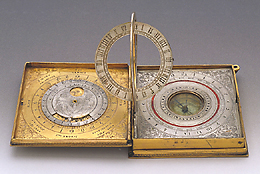
 |
| Catalogue |
 |
 Astronomical Compendium Face Ib: Circular scale of wind directions, the points being named in German: 'Svd / Gewilck', 'Svd west / Regen', 'West / Trie', 'Nort west / Schonschaur', 'Nort / schonkalt', 'Nort ost / Schonkalt', 'Ost / schon', 'Svd ost / Halbschon'. Within this is a lunar volvelle for the age and phase of the moon marked 'DIES ?TATIS LVN?' and carrying a 2 ? 12 hour scale on its edge for converting between lunar and solar time against a second 12 ? 2 hour scale reading to 15 minutes drawn within the circle of wind directions. The centre of the volvelle is decorated with two seated figures clasping hands above a pillar. This scene is virtually identical with that engraved on the reclining dial face of a polyhedral dial in the Florence collection (Epact 20011). The corners of the dial are filled with the heads of cherubs blowing winds. Between faces Ib and IIa an equinoctial dial, which may be folded flat, is mounted on a base composed of two monsters belching forth leaf forms. The dial is adjustable by a brass slip ring within the meridian ring for latitudes 42 to 54? and is graduated on the winter side with an undivided hour scale (1 to 12 ? 2) in Arabic numerals and on the summer side with an hour scale divided to 15 minutes in Gothic numerals. Face IIa: Inset central compass with the cardinal points named in Latin and magnetic declination mark for approximately 5? east. Surrounding the compass is a ring decoratively filled with red paint, and around this a division into 48 points numbered by pairs in the South German/Bohemian manner in two scales of 12. The corners are filled with symmetrical foliate decoration. Face IIb: Base of compass box engraved with the head of a warrior; surrounding base plate with formal flowing leaf decoration within a circle; corners with symmetrical leaf decoration similar to that on leaf IIa. Face IIIa: Table of the planetary governors of the hours of the day and the night titled in Latin 'HOR? PLANETARVM DIEIS' 'NOCTIS', but with the week day names in German. Face IIIb: Horary quadrant with undivided hours and zodiac scale with the signs named in German above a degree scale reading to 1? by alternating hatched and unhatched divisions numbered by groups of five. Above the hour scale is a shadow square of twelve surrounding, in the apex, a scene of a surveyor in a landscape measuring a solar altitude with a quadrant, the very long plumb line of which also serves to mark the centre line of the instrument. Below the hour table is a further scene of astronomers and surveyors measuring a solar altitude, the heights of buildings in a landscape, and position fixing on a sphere. The edges of the instrument are plain, but there is a ring at the apex for suspending the instrument when the horary quadrant is to be used. Provenance Medici collections. The dial appears as no 190 in the 1595 inventory of the wardrobe of the Grand-Duke Ferdinand I. This instrument should be compared with the small portable polyhedral dial (Florence, inventory 2477). Not only do the two instruments share a general similarity of style in the use of figural decoration to fill angles and corners of the instrument, as well as formal and flowing leaf decoration, but the scene of two seated figures clasping hands is, as noted above, virtually identical on the two instruments for pose and treatment although there are slight variations in facial expression. The numeral punches used on these two faces also appear to be the same. They are fractionally over 2 mm in height and the distinctive 5 composed almost of two arcs, the 2 with an exaggerated bottom right descending serif and the I with unequal serifs to left and right at both ends of the vertical member, are all present on both instruments. It seem therefore not unjustifiable to ascribe the two instruments to the same workshop. Anthony J. Turner |



